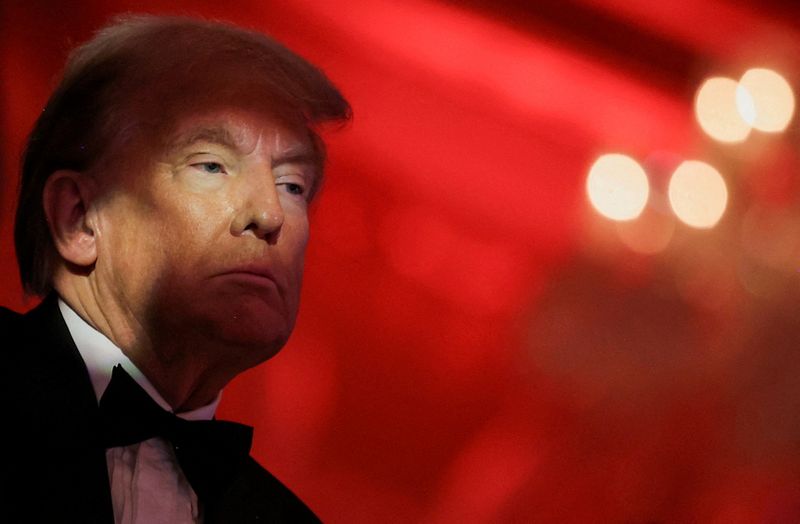By Sinéad Carew and Amanda Cooper
NEW YORK/LONDON (Reuters) -The U.S dollar rose against some currencies on Tuesday after U.S. President-elect Donald Trump pledged to impose new tariffs on imports from Canada, Mexico and China, while MSCI’s global equity index was higher after the release of the Federal Reserve’s latest meeting minutes.
The minutes from the meeting earlier this month showed officials divided over how much farther they may need to cut interest rates, but in agreement about avoiding concrete guidance about how policy would evolve in the weeks ahead.
“With the stock market, no surprises is good news. The market likes certainty above anything else,” said Burns McKinney, portfolio manager at NFJ Investment Group in Dallas. “Overall, Fed policymakers are still supportive of a careful approach. … They didn’t say anything hawkish.”
The rose 123.74 points, or 0.28%, to 44,860.31; the rose 34.26 points, or 0.57%, to 6,021.63; and the rose 119.46 points, or 0.63%, to 19,174.30.
After Wall Street had closed, MSCI’s gauge of stock markets across the globe turned higher and was up 1.52 points, or 0.18%, at 859.27. Europe’s index earlier closed down 0.57%.
While it was below its session high, the dollar was still up against the Mexican peso and Canadian dollar in afternoon trading.
Trump, citing concerns over illegal immigration and illicit drug trading, had said earlier that he would put a 25% tariff on products from Mexico and Canada, and an additional 10% tariff on goods from China. He had previously threatened to slap tariffs in excess of 60% on Chinese imports.
But investors toned down their initial reactions to the tariff threat and appeared to view it as a “negotiation tool,” according to McKinney.
However, U.S. Treasury yields rose on Tuesday, as Monday’s sharp bond rally lost momentum with the tariff announcement undoing some of the investor optimism from Trump’s selection late last week of Scott Bessent as Treasury secretary.
“Concern about the tariffs and concern about the U.S. deficit are what’s weighing on the market for the ability of the Fed to really cut,” said Matt Eagan, portfolio manager and head of the Full Discretion Team at Loomis (LON:), Sayles & Co.
The yield on benchmark U.S. 10-year notes rose 3 basis points to 4.293%, from 4.263% late on Monday while the 30-year bond yield rose 1.8 basis points to 4.4647%.
The yield, which typically moves in step with interest rate expectations, was flat at 4.252%, from 4.252% late on Monday.
In currencies, the Mexican peso < MXN=> weakened 1.6% versus the dollar at 20.66 while the Canadian dollar weakened 0.56% to 1.41 per U.S. dollar.
Oil prices settled lower, slightly extending Monday’s losses in choppy trade after news of an agreement for a ceasefire between Israel and Lebanon, reducing oil’s risk premium.
settled down 0.25% at $68.77 a barrel and ended at $72.81 per barrel, down 0.27% on the day.
was down 2.80% at $91,064.35, adding to Monday’s losses after last week hitting a record high at $99,830. The token had benefited from speculation of an easier regulatory environment for cryptocurrencies under Trump.

In precious metals, gold prices were caught in a tug-of-war, dipping to a week low as safe-haven demand softened with news of the ceasefire, while concern over Ukraine and Trump’s tariff plans added some support.
rose 0.29% to $2,632.81 an ounce. U.S. rose 0.34% to $2,625.60 an ounce.
Source link

















